Nassau County to Adopt New Legislature Map with Six Minority Districts

Nassau County, NY and voters of color agreed Wednesday to a new county legislature map in a settlement ending a year-long lawsuit that brought into question the constitutionality of the New York Voting Rights Act (NYVRA).
Without admitting to any violation of state laws, Nassau County agreed to a redrawn map that increases the number of majority-minority districts from four to six out of 19 districts in the southwest quadrant of the county.
“This map is a big step towards equality and fairness in our community’s democracy,” said Lisa Ortiz, a plaintiff in the case. “After years of having our votes and voices diluted and ignored, we finally have an equal voice at the polls. We’re deeply gratified that our case delivered fairness for voters — and that voters of color will now have as much say as anyone else in Nassau County.”
According to Perry Grossman, director of the Voting Rights Project at the New York Civil Liberties Union (NYCLU) and lead counsel for the plaintiffs, the new map will ensure communities of color in districts 3, 6 and 14 like Lakeview and Freeport are able to elect candidates of their choice. It also reconfigures existing majority-minority districts of 1, 2 and 5, and consolidates the Asian community in district 9.
Nassau County Supreme Court Justice Paul I. Marx, who oversaw the case, signed off on the agreement Thursday. The legislature is expected to pass the new map and send it to the county executive for his signature by Feb. 5.
New York Communities for Change and four Latino voters filed a lawsuit in February 2024 alleging Nassau County’s February 2023 redistricting plan violated the NYVRA and the Municipal Home Rule Law (MHRL) by discriminating against Black, Latino and Asian voters. The NYVRA — signed into law in June 2022 — prohibits drawing electoral districts in a way that limits or weakens a group’s voting power.
According to the complaint, the Nassau County Legislature packed communities of color into four out of 19 districts and cracked a large, compact Asian community into three districts to dilute its voting power. The plaintiffs allege that if the Legislature had complied with the NYVRA, the redistricting map would include six majority-minority districts where Black, Latino and Asian voters could have real influence over election outcomes.
Between 2010 and 2020 censuses, the non-Hispanic white population of Nassau County decreased by 11%, whereas Black, Latino and Asian populations grew dramatically to make up nearly half of the county’s population and over one-third of its eligible voters. Yet, Nassau County remains the country’s most segregated county in its population class today.
Nassau County attempted to dismiss the case, arguing that the plaintiffs waited too long to bring it. After Marx rejected the attempt, defendants argued that the NYVRA is unconstitutional.
The 14th Amendment’s Equal Protection Clause prohibits race from being considered in redistricting, except when there is a compelling governmental interest and the action is narrowly tailored. Section 2 of the federal Voting Rights Act (VRA), which is used to remedy discriminatory maps, is an example of a law that meets this high legal standard. Nassau County argued that the NYVRA’s vote dilution provisions go beyond the VRA and violate the 14th Amendment for not being sufficiently narrow or compelling, comparing the NYVRA to affirmative action programs.
Marx ruled against the defendants, writing “The NYVRA does not confer benefits upon any individual and it does not guarantee successful outcomes to any individual or group. Instead, it seeks to provide equal opportunity in voting.”
The case went to trial before Marx in late December and early January.
After the first week of trial, Nassau County urged a federal district court to take up the case, arguing that the plaintiffs’ sudden reliance on Section 2 during trial made the case a federal issue. A federal judge in Brooklyn rejected the move, citing legal briefs showing that Section 2 was not new to the plaintiffs’ argument.
On Jan. 5 — the Sunday before the second week of trial — Nassau County sought to disqualify Marx for allegedly making biased statements and prejudging the case before defendants had an opportunity to present their case. On Jan. 6, Marx denied the motion to disqualify and the trial resumed.
Grossman maintains that Marx conducted a complex case in an exemplary manner. “This was the first case resolved under the NYVRA and the first case involving a redistricting plan challenged under a state voting rights act anywhere in the United States. [Marx] dealt with a lot of interesting, novel issues.”
Wednesday’s settlement — which was reached on the last day of trial — creates a new map that the NYCLU says is “politically fair,” unlike the original map that strongly benefited Republican candidates. The new map will be used for Nassau County Legislature elections until it is redrawn following the 2030 census.
“This historic settlement says it loud and clear: efforts to partisan gerrymander and to deny communities of color their constitutionally-protected power at the ballot box will not stand in New York,” said Grossman. “Using all the tools and protections we secured in the New York Voting Rights Act and the Municipal Home Rule Law, every voter in Nassau County will now have a fair, equal opportunity to make their voice heard. 2025 elections are around the corner and, with this settlement, Nassau voters will have a real chance to elect legislators who truly represent their interests.”
Legal battles over the NYVRA are not over, however. The NYVRA is currently being litigated in the New York intermediate appellate court after an Orange County judge ruled that the law violated the 14th Amendment. Voters in Mount Pleasant and Cheektowaga are also using the NYVRA to challenge at-large electoral methods that they say dilute the voting power of Black and Hispanic communities.